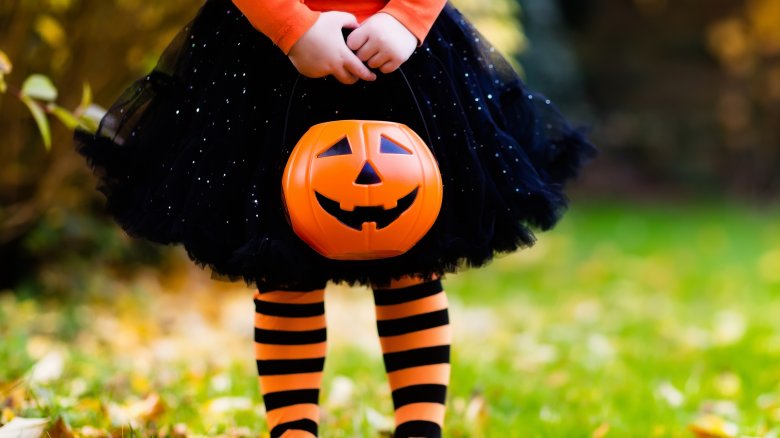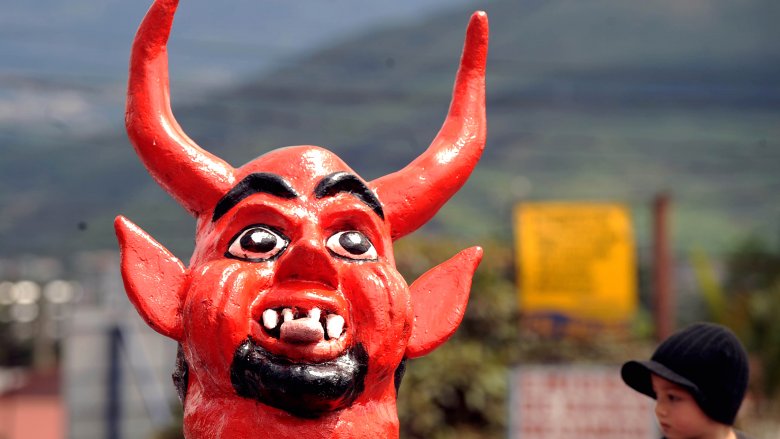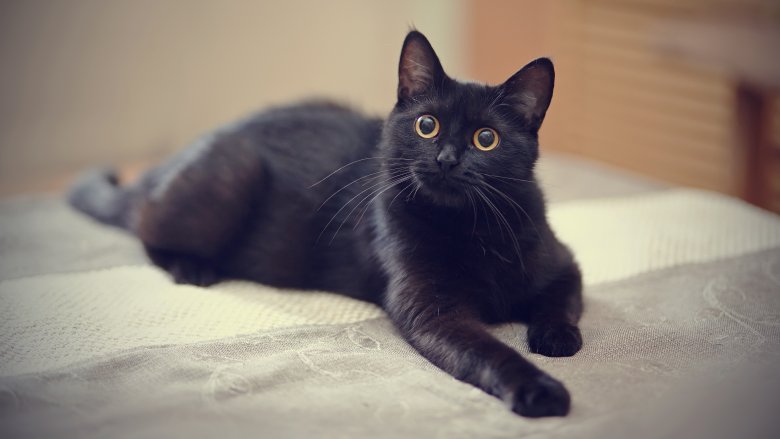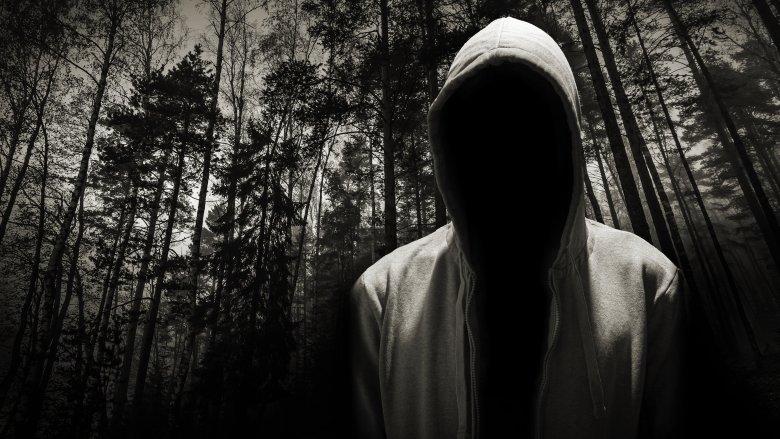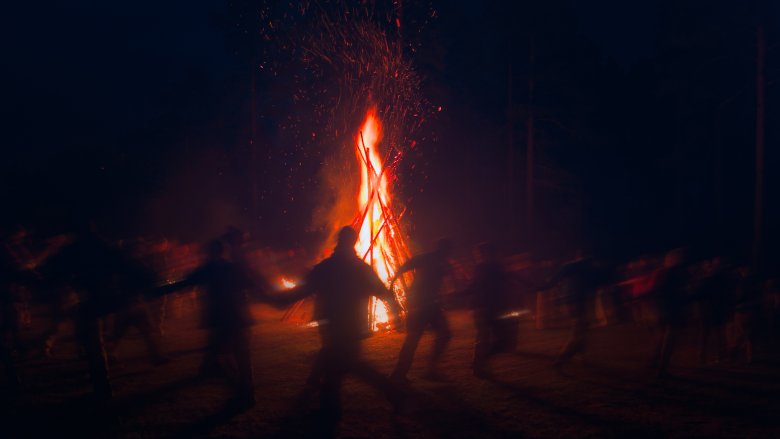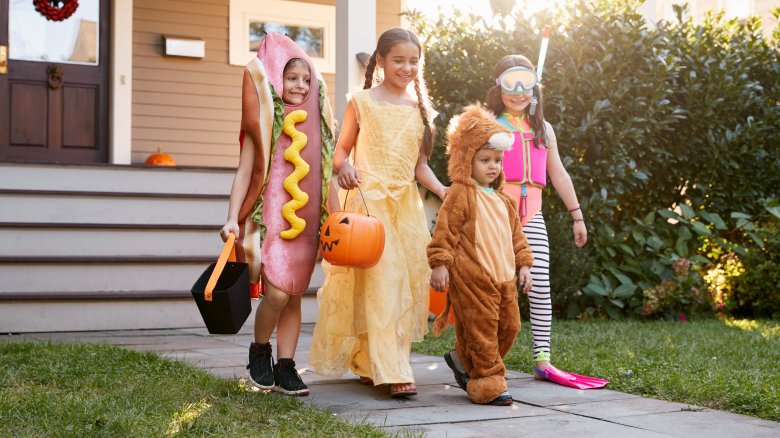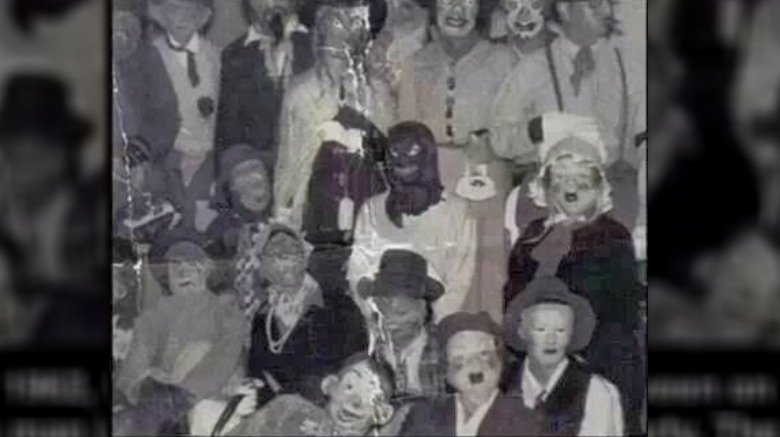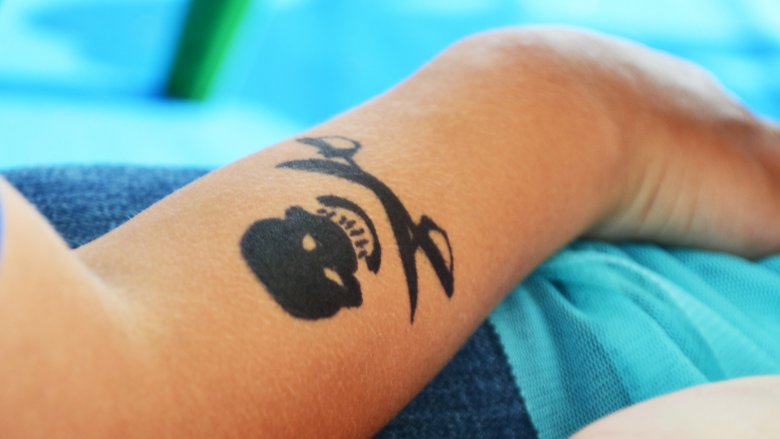The Biggest Halloween Myths You've Been Believing
Halloween is a weird holiday. At no other time of year can you dress up like a rotten corpse or a superhero, stroll around crowded places with no social repercussions, and then spend the evening barfing up all the candy you overate. (Okay, maybe you could do all that at Comic-Con.) And it's probably because Halloween is so weird, and because the people who love Halloween can be extra weird, that there are so many half-truths, strange ideas, and myths surrounding our favorite autumn excuse to knock on strangers' doors and demand candy.
It will hopefully comfort you to know that most of the stories you've heard about the horrors of Halloween are just that — stories. Some of them are meant to scare you into not celebrating Halloween anymore, some of them are meant to scare you into being an overprotective parent, and still others are just meant to scare you. After all, that's what Halloween is all about. So feel free to flee in terror from all those Pennywises and rotten corpses, but remember that some of the scariest Halloween stories are really nothing to be afraid of.
Child-haters handing out poisoned candy
Relax, parents. Most child-haters turn off the porch light on Halloween, or head down to the Lodge of the Royal Order of Child-Haters to wait out the festivities. There is no epidemic of child-haters putting razor blades and poison in Halloween candy just for a laugh, though plenty of kids will tell you that those old ladies who hand out granola bars and bags of unbuttered popcorn are downright evil.
According to SafeKids.org, parents' perception of the risk of tainted candy is disproportionate to the actual risk. Around 24 percent of those surveyed think poisoned/razor-bladed candy is an actual thing, which ranks just below fears of pedestrian injury on Halloween. But it's only the latter that should really concern parents — about twice as many kids are killed in pedestrian/vehicle incidents while trick-or-treating as during other times of the year, but there is no increase in the already-zero number of kids killed by candy.
Sociology professor Joel Best says he has never seen evidence of a single child killed by Halloween candy tampering. Many of the widely publicized incidents can be attributed to something else — for example, in 1974 an 8-year-old boy died on Halloween after eating cyanide-laced candy, but he got the candy from his (absolutely awful) father, who was planning to collect on an insurance policy and blame the death on trick-or-treating. So yes, real monsters do come out on Halloween, they're just not usually strangers.
Halloween is the devil's holiday
If you want a good laugh you should check out some of the websites devoted to demonizing Halloween as the devil's holiday — they sure are funny. Some religious groups claim "it is impossible to separate the dark origins of Halloween from the seemingly harmless practices of today," even though, guess what, Halloween has no "dark origins." According to ThoughtCo, Satanism as a religion didn't even exist until 1966, and Halloween is a lot older than that.
If you want to go all the way back to the beginning, Halloween is a Celtic holiday. Traditionally, people would light bonfires on Halloween (they called it Samhain) and wear costumes to deter ghosts and evil spirits. Then Catholicism came along, and the Pope was all, "Hmm, how can we make this pagan festival more Christian?" So he declared November 1 to be "All Saints Day," and the night before became "All Hallows Eve." A lot of the pagan traditions remained pretty much the same, but they were basically incorporated into the new Christian traditions and everyone was happy right up until someone wasn't.
Now, those who still think Halloween is the Devil's holiday often argue that those pagan traditions are actually the devil's traditions, because, you know, anything that isn't Christian is demonic. If that's true, we probably also need to include Christmas among the devil's holidays, since the traditions of decorating trees and burning (or eating) a Yule log are actually also pagan in origin.
Lock up your kitty
You've probably heard stories of black cats who were abducted and tortured on Halloween — these tales are second in horror only to stories of kids eating poisoned candy. But like those poisoned candy stories, there isn't really any evidence that black cats (or any other kinds of cats) are in great danger at the end of October.
To believe this particular urban legend, one would also have to believe in the whole Halloween-as-Satanism urban legend because according to the myth, black cats are captured and tortured on Halloween as a part of those dark rituals that Satanists are so into. According to Vet Street, there are also other somewhat more benign versions of this myth, which includes the idea that black cats are adopted to function solely as party decorations and are then abandoned on November 1.
None of it is really true, though. Most shelters have pretty rigorous screening processes in place to make sure animals aren't adopted for the wrong reasons and to the wrong people. And when pets go missing, it's a lot more likely to be coyotes than Satanists. That's an argument for keeping your black cat (and any other color cat) indoors all the time, not just on Halloween.
Demons, vampires, and predators
Demons, vampires, and evil spirits roam the streets on Halloween, except on Buffy the Vampire Slayer — Sunnydale demons, vampires, and evil spirits stay home because they think the holiday is "much too crass" and commercialized.
Like Sunnydale demons, sex offenders take the night off, too — or at least are no more active on Halloween as they are on any other night of the year. There's probably a very logical reason for this: Halloween is a big, crowded holiday and the streets are full of kids and watchful parents, meaning it isn't exactly a prime opportunity to snatch someone's kid without someone else taking notice.
According to LiveScience, the idea that children are somehow more susceptible to becoming the victim of an abduction or crime on Halloween is mostly theoretical, and doesn't really have any strong evidence to back it up. Those who posit the theory argue that bad guys have more opportunities to interact with kids on Halloween, and can easily hide their identities in costumes. But there's plenty of research that says these fears are mostly unfounded. A 2009 study looked at 67,307 "non-family" sex offenses against children and found that there was no evidence to support an uptick in such crimes on the last day of October.
Back to that Satan thing again
Even if Halloween is technically not a Satan thing, some people will still argue that it has dark and sinister roots because the Druids celebrated it, and Druidism equals human sacrifice. Except no, there really isn't much evidence to support the idea that the Druids sacrificed human beings on Halloween (or at any other time).
According to some religious leaders, though, the Druids were up to all kinds of no-good — Pat Robertson seems to think trick-or-treating originated with them, too. "The whole idea of trick-or-treating is the Druids would go to somebody's house and ask for money, and if they didn't get money, they'd kill one of their sheep. I mean, that was the trick." Pat Robertson appears to have totally made that up, but whatever. In fact when the Druids did make sacrifices to the dead, it was mostly in the form of crop burning. Not exactly the most healthy or sustaining sort of ritual sacrifice, but it certainly didn't involve killing people, or sheep.
The whole idea of the Druids and human sacrifice actually appears to have originated from a single source — a book about the Gauls written by Julius Caesar. Much of the literature that came afterward got the notion of druidic human sacrifice directly from Caesar's writings, and not from any actual physical evidence.
Trick or treat is an American thing
Trick-or-treating has certainly been popularized in America — in fact it appears to have actually been ordained by local governments in the 1930s as a way of keeping school kids out of trouble on Halloween. But long, long before it was a way for kids to bankrupt entire neighborhoods, it was meant to keep evil spirits at bay. Contrary to popular belief, wearing costumes was not supposed to help the Celts honor or emulate evil spirits: It was supposed to fool evil spirits. So if you encountered, say, the wandering spirit of Lightning McQueen while you were wearing a Lightning McQueen costume, the real Lightning McQueen would figure you were just another Lightning McQueen spirit and let you go on your way without trying to sell you Rusteez.
Anyway, according to Smithsonian, at some point (after Samhain had been usurped by the Catholic church) costume wearing became "guising." Costumed kids would go from door to door offering to trade prayers on behalf of the dead in exchange for food and money, which sounds an awful lot like trick-or-treating today, except prayers on behalf of the dead became promises not to egg your house. (Of course, egging hardly ever has a place in modern Halloween celebrations.)
So trick-or-treating is really European, it's just been adopted rather enthusiastically by American children.
The 1962 Halloween massacre
Photoshop has brought us the wonderful ability to crop, straighten, sharpen, and remove pimples. It has also made it possible to turn photos into convincing images of horror, which are then forwarded all over the internet until Snopes finally gets involved.
The photo above is probably not tampered with, but it looks super-creepy, which is why so many people believed the story that was attached to it. The story goes like this: "On Halloween on 1962, there was a costume party. The man in black mask locked all the doors from outside and tried to kill all of them. The man ended up killing only 7 people using a kitchen knife. He was never caught but the mask was found in 1969, the FBI has it in custody."
Now, forgetting about all the grammatical and logistical problems of this story (how exactly does one keep a mask "in custody," and how would one get back inside a building after locking all the doors from the outside, and then escape again afterward?), if you do a thorough search for 1962 Halloween murders you will find no such incident reported anywhere in the media, even though it almost certainly would have made headlines all over America.
So what is this super creepy photo? It's just that — a super creepy photo from an uneventful party. Well, maybe some people vomited their candy, but that's probably as bad as it got.
Halloween trips
You were just starting to relax about the whole taking candy, granola bars, and bags of popcorn from evil old ladies thing, so now let's talk about those tattoos. You remember the tattoos — first it was blue stars, then it was Bart Simpson.
Supposedly, drug dealers were passing out LSD-laced tattoos and when kids "licked and sticked" them, they'd go on a wild Halloween adventure that had nothing to do with wandering the neighborhood in a Star Wars costume.
Snopes looked into this particular rumor and discovered — surprise — that there isn't a single verifiable case of an LSD-laced tattoo showing up in a bag of Halloween candy. If you still think this rumor might be true, it's worth a little critical thinking. If a drug dealer were hoping to attract new customers with his LSD-laced tattoos, surprising some poor little kid with an unexpected and terrifying hallucinogenic experience is probably not the way to do that. There's also the part where little kids don't make great drug customers because their tooth fairy money usually isn't enough to support a habit. Also, LSD isn't exactly addictive, so it's not like they're going to be desperately stealing other kids' tooth fairy money to get their daily fix. But hey, if you're still worried, just quietly toss out all the tattoos you find in your kids' bag this year. Chances are they'll be so busy barfing up 27 mini Butterfingers that they won't even notice.
The economy cannot survive on candy alone
Here's the most bizarre Halloween myth of all — that our favorite spooky holiday is second only to Christmas in terms of dollars spent. Um, what? Since Time says the average person spends around $476 on gifts alone during the winter holiday season (plus $115 on food and $78 on decorations) it's hard to imagine just what people might be buying on Halloween that could possibly get close to that — $600 is an awful lot of granola bars and microwave popcorn. There's also the costume, and granted, the Spirit Halloween superstore does have ridiculous markups, but most people have figured out they can get much cheaper costumes from Amazon or Goodwill. So unless you're really, really into the cosplay thing and you've got some money to burn, you're probably not going to spend that much money on Halloween.
So what holidays top Halloween in terms of consumer spending? Pretty much all of them. Mother's Day, Father's Day, Valentine's Day, and even Easter are bigger than Halloween, which leaves Thanksgiving and the Fourth of July bringing up the rear as the stingiest, but mostly barf-free holidays of the year.
